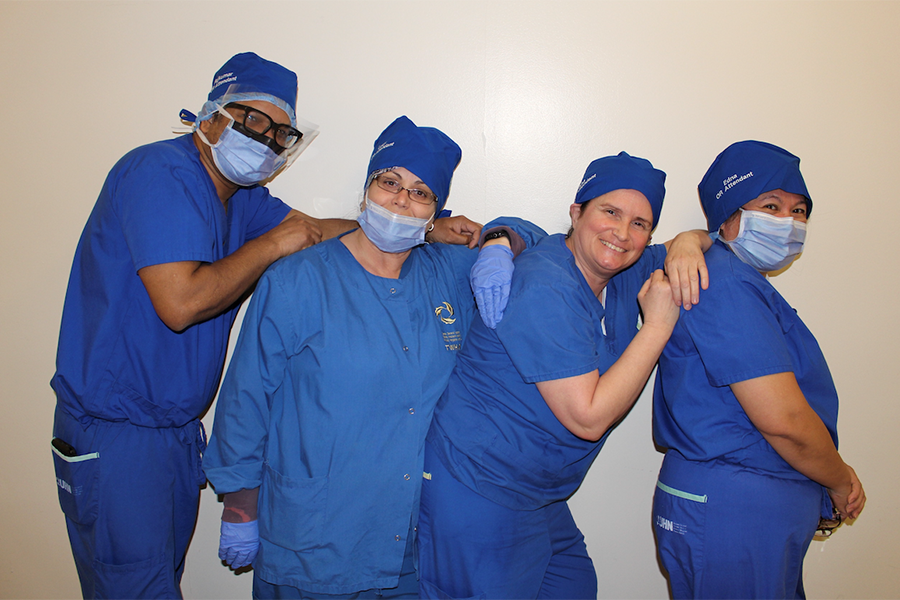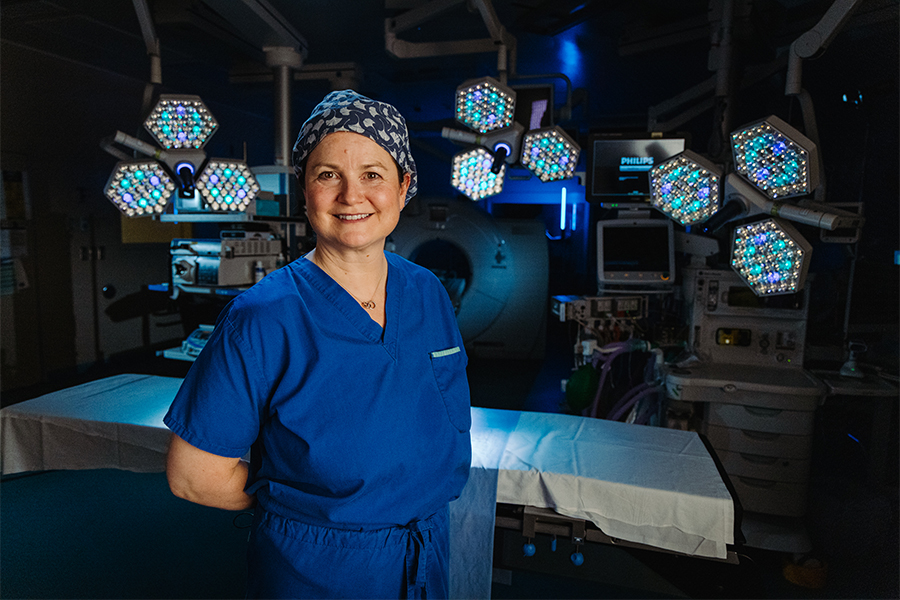Sprott Surgery has employed minimally invasive machine-powered surgical techniques for many years. Here are just some of the innovators who continue to push the boundaries of robotic surgery today. Kate Mlacak (pictured above) is a vital part of Sprott Surgery’s expanding robotics program. (Photo: Regina Garcia)
By Anna Sharratt
Kate Mlacak: The driver
If it wasn’t for Kate Mlacak, a registered nurse and robotics coordinator at University Health Network (UHN), the pace of robotics advancement at UHN would be dramatically slower. That’s because Mlacak has been instrumental in expanding the program and training the nursing staff on how to prepare the Da Vinci Surgical System, a multi-armed machine that surgeons use to conduct a wide range of minimally invasive surgeries. The system, which has several tool-holding arms, is operated from a separate console within the operating room (OR).
When Mlacak started her position as a robotics coordinator 10 years ago, robotic surgery at UHN was in its infancy. It was mostly confined to gynecological oncology surgery and prostatectomies. Since then she has watched the scope of treatment grow exponentially. Surgeons now perform everything from oropharyngectomy (a minimally invasive head and neck operation done through a patient’s mouth) to nipple-sparing mastectomies. “I’ve been there to watch the program grow, and it has expanded in leaps and bounds,” says Mlacak.
One of Mlacak’s responsibilities is to stay on top of what’s happening in the robotic surgery realm, especially given how quickly technology can change. She spends countless hours watching videos and reading papers on how other teams from around the world put these systems to use. She then shares her learnings with her colleagues. “For every surgery, the OR has a different configuration,” she explains, which means she needs to know where to place these robotic tools so that floor space is optimized for the surgical team. “It’s exciting that we can do these really massive surgeries and really big cases in a minimally invasive way.”
It’s the constant learning and improvement in patient care that drives her and her team of nurses. “I’m always doing something new for my patients,” she says. “We’re doing some really innovative things.”
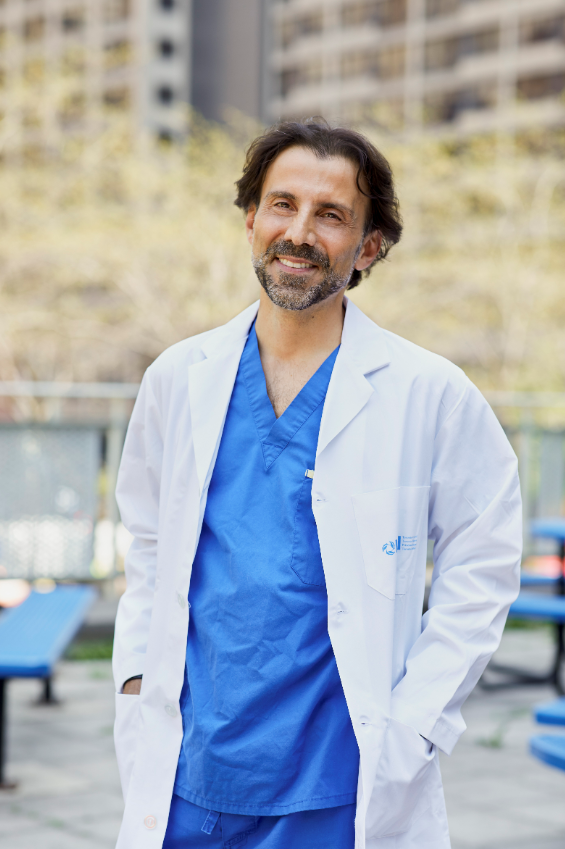
Dr. Tony Finelli: The leader
Dr. Tony Finelli is a master at non-invasive laparoscopic urologic procedures, which involve performing small incisions during radical prostatectomies, the removal of the prostate, and partial nephrectomies, the surgical removal of kidneys. The Head of the Division of Urology in the Sprott Department of Surgery and Chief of Urology at UHN has done more than 1,000 of these procedures since 2008, all of which reduce complications, cut down the length of a patient’s hospital stay and lead to better outcomes than open surgery.
So when the robotic system was first introduced at UHN, Dr. Finelli welcomed the opportunity to harness its precision in the treatment of urological malignancies. “The robot accelerated the pace of the adoption of minimally invasive surgery. This technology allows you to spin your ‘hands’ 360 degrees,” he explains, allowing for a tumour to be excised more precisely. Combining magnification with dexterity has enabled robotics for complex surgeries and hard-to-reach areas.
Dr. Finelli looks forward to the day when artificial intelligence (AI) will be integrated into robotic platforms to help surgeons increase safety and more accurately identify internal structures. The development of innovative imaging will help spare nerves, providing patients with better sexual function after the surgery and a higher quality of life. “Imagine a tracer – an agent that lights up certain areas of the body – that can identify where the nerves exist around the prostate,” he says. “That’s the exciting future.”
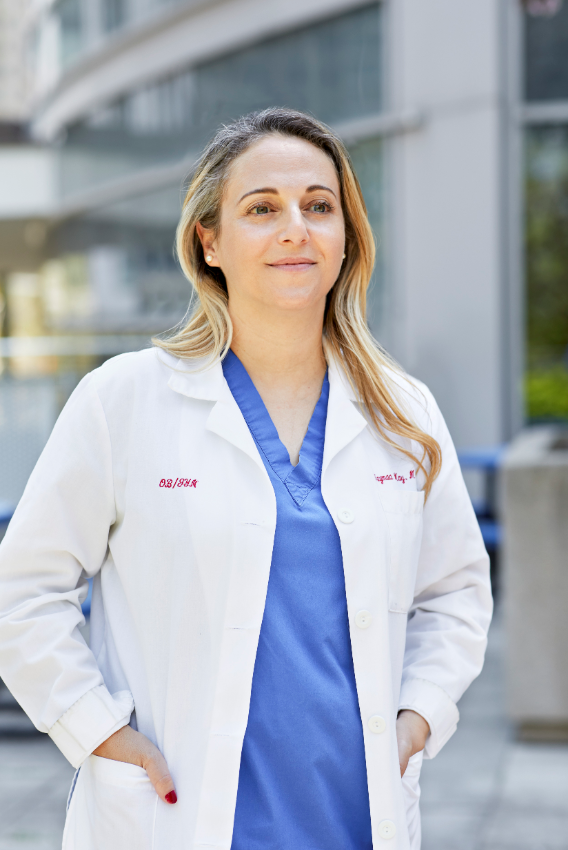
Dr. Taymaa May: The pioneer
For women with cervical cancer, treatment used to involve the complete removal of the cervix and uterus, leaving them cancer-free but without the ability to have children, says Dr. Taymaa May, a gynecologic oncologist in the Sprott Department of Surgery. But increasingly, surgeons like Dr. May are using a revolutionary technique called a radical trachelectomy to treat cervical cancer, removing the cervix, the upper part of the vagina, the lymph nodes and the supporting tissues, while preserving the uterus and the ovaries.
The six-hour, computer-assisted surgery, using a robotic arm, allows for minimally invasive laparoscopic incisions, and facilitates precise removal of the cancer tissue and the associated lymph nodes. “The patients have smaller incisions in their abdomen, less pain and they can go home the same day,” says Dr. May. In the past they would have been hospitalized for four or five days.
But the biggest advantage of radical trachelectomy is that it preserves fertility. “Women have the option of carrying a pregnancy at a later time,” explains May, who’s one of fewer than 10 surgeons in Canada to have performed this surgery.
She has also expanded the procedure to treat another rare cancer that affects young women, adolescents and girls under age 18: rhabdomyosarcoma of the cervix, an aggressive cancer that forms in muscle tissue. “I have done this surgery for girls as young as two years old. Thankfully because of the surgery and chemotherapy they have the opportunity to reach adulthood – and the ability to get pregnant if they choose to do so in the future,” she says. “It’s amazing.”
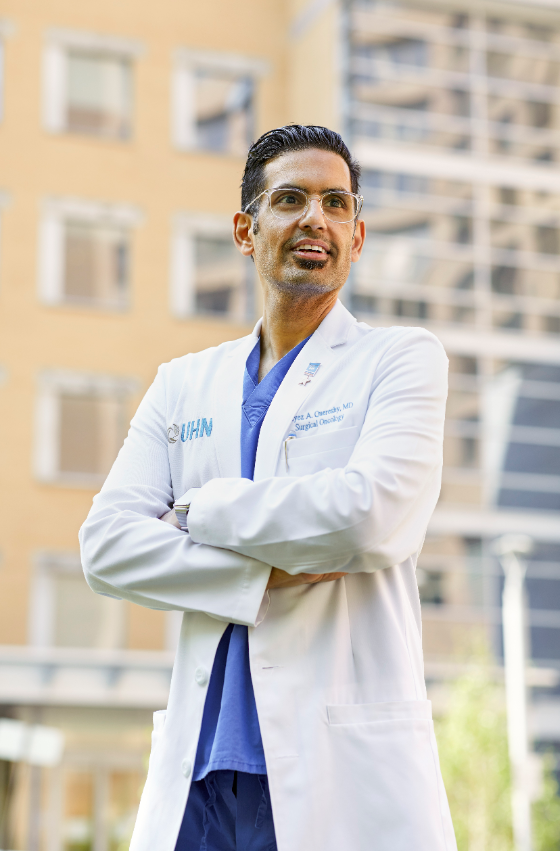
Dr. Fayez Quereshy: The trailblazer
Dr. Fayez Quereshy specializes in intestinal malignancies. So when the opportunity arose in 2011 to study robotic surgery in Hong Kong, a city known for its early adoption of robotic medical procedures, he jumped at the chance. “It was an outstanding experience,” Dr. Quereshy says of his training, where he advanced his knowledge of how to use the robotic platform to treat colon and rectal cancers.
Back home, his training was put to use alongside the groundbreaking work of Dr. Finelli. “We were one of the first groups in Canada to do robotic rectal cancer surgery,” says Dr. Quereshy, UHN’s Clinical Vice President and a surgical oncologist in the Sprott Department of Surgery.
Compared to traditional surgery, which involves a large abdominal incision from above the belly button to the pubic bone, Dr. Quereshy and his team make small keyhole incisions in the abdomen. “The surgical trauma is much less due to the robotic footprint,” he says. “Patients have reduced the need for intensive care units, reduced blood transfusion requirements and have a higher probability of completing the surgery with a minimal access approach.”
Dr. Quereshy hails the technical advantages of the robotic platform, as tissues can be dissected in tight corners and there’s less worry of cancer cells being left behind. Patients recover more quickly, retain anal sphincter function and need a permanent ostomy bag less often. “It’s what our patients need,” says Dr. Quereshy. “Being robotically enabled lets us get to the next level.”

Dr. Tom Waddell: The visionary
Dr. Tom Waddell is a big proponent of video-assisted surgery when performing minimally invasive lung cancer operations. The enhanced ability to see areas within the body, the opportunity to operate without holding a camera, the higher sensitivity and the ability to spin in all directions allow him to perform precise removal of lung tumours. “Each camera goes to a separate eyeball of the surgeon so you have depth perception,” similar to a pair of glasses, says Dr. Waddell, a thoracic surgeon in the Sprott Department of Surgery and the Richard and Heather Thomson Chair in Thoracic Translational Research. “And that facilitates a lot of aspects of surgery.” He also appreciates the range of motion provided by the robotic platform, which allows a surgeon to access more areas in the lung and eliminates any possible unsteadiness.
He, too, is looking forward to a time when AI becomes integrated into the robotic platform. “We need to participate in the development of technology that’s at the leading edge,” he says. “What are the things surgeons need to do their job better, and how can we use that to push the limits of what we want to do? This is an exciting time to think about robotic surgery.”
